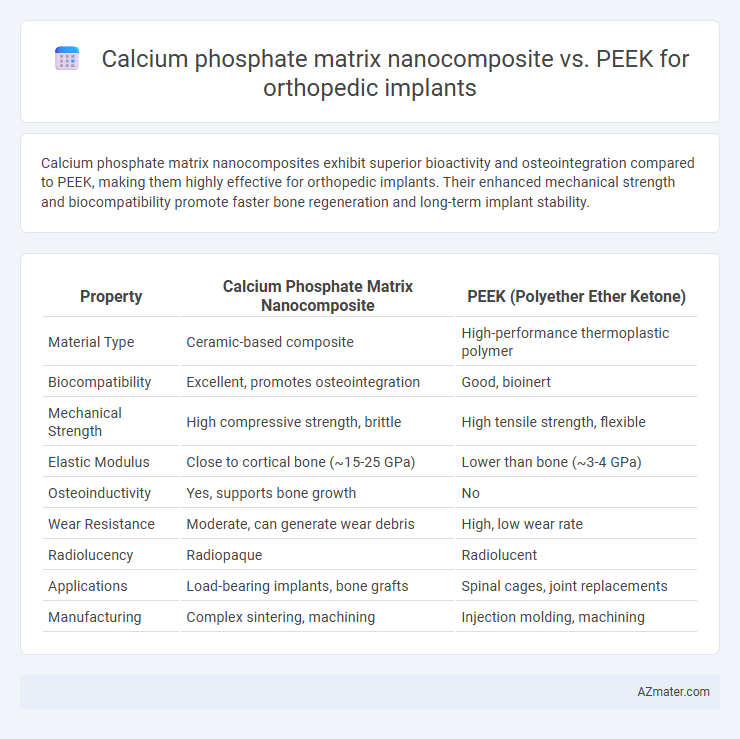Calcium phosphate matrix nanocomposites exhibit superior bioactivity and osteointegration compared to PEEK, making them highly effective for orthopedic implants. Their enhanced mechanical strength and biocompatibility promote faster bone regeneration and long-term implant stability.
Table of Comparison
| Property | Calcium Phosphate Matrix Nanocomposite | PEEK (Polyether Ether Ketone) |
|---|---|---|
| Material Type | Ceramic-based composite | High-performance thermoplastic polymer |
| Biocompatibility | Excellent, promotes osteointegration | Good, bioinert |
| Mechanical Strength | High compressive strength, brittle | High tensile strength, flexible |
| Elastic Modulus | Close to cortical bone (~15-25 GPa) | Lower than bone (~3-4 GPa) |
| Osteoinductivity | Yes, supports bone growth | No |
| Wear Resistance | Moderate, can generate wear debris | High, low wear rate |
| Radiolucency | Radiopaque | Radiolucent |
| Applications | Load-bearing implants, bone grafts | Spinal cages, joint replacements |
| Manufacturing | Complex sintering, machining | Injection molding, machining |
Introduction to Orthopedic Implant Materials
Calcium phosphate matrix nanocomposites exhibit superior bioactivity and osteoconductivity compared to traditional materials, promoting faster bone integration in orthopedic implants. Polyether ether ketone (PEEK) offers excellent mechanical strength and biocompatibility but lacks inherent bioactivity, often requiring surface modifications for enhanced bone bonding. The combination of calcium phosphate's bone-mimicking properties with PEEK's durability aims to optimize implant performance by balancing biological and mechanical requirements.
Overview of Calcium Phosphate Matrix Nanocomposites
Calcium phosphate matrix nanocomposites exhibit exceptional biocompatibility and osteoconductivity, promoting natural bone growth and integration, which makes them highly suitable for orthopedic implants. Their nanostructured matrix mimics the mineral phase of bone, enhancing mechanical strength and bioactivity compared to conventional materials like PEEK (polyether ether ketone). These composites offer improved bioresorbability and support bone regeneration, addressing limitations related to PEEK's bioinertness and insufficient osseointegration.
Key Properties of PEEK in Orthopedics
PEEK (polyether ether ketone) is a high-performance thermoplastic known for its exceptional biocompatibility, chemical resistance, and mechanical properties comparable to human bone, making it ideal for orthopedic implants. Its radiolucency allows clear imaging post-implantation without interference, aiding in effective diagnosis and monitoring. The inherent flexibility and fatigue resistance of PEEK reduce stress shielding, promoting better load transfer and long-term implant stability in orthopedic applications.
Mechanical Strength Comparison
Calcium phosphate matrix nanocomposites exhibit superior bioactivity and osteoconductivity compared to PEEK, but PEEK offers higher tensile strength and fracture toughness, making it more resistant to mechanical stress in orthopedic implants. The elastic modulus of calcium phosphate nanocomposites is closer to natural bone, reducing stress shielding, whereas PEEK's mechanical strength supports load-bearing applications with long-term durability. Optimization of composite formulations aims to balance the mechanical properties of calcium phosphate matrices with the resilience of PEEK for enhanced implant performance.
Biocompatibility and Bioactivity Analysis
Calcium phosphate matrix nanocomposites demonstrate superior biocompatibility and bioactivity compared to PEEK in orthopedic implants, primarily due to their chemical similarity to natural bone mineral, which promotes osteointegration and bone regeneration. The inherent bioactivity of calcium phosphate materials facilitates the formation of a direct bond with bone tissue, enhancing implant stability and accelerating healing processes, whereas PEEK's bioinert nature often necessitates surface modifications to improve cellular responses. In vitro and in vivo studies consistently show higher cell proliferation, differentiation, and mineralization rates on calcium phosphate nanocomposites, resulting in improved long-term implant performance and reduced risk of implant rejection.
Osteointegration Capabilities
Calcium phosphate matrix nanocomposites exhibit superior osteointegration capabilities compared to PEEK due to their chemical similarity to natural bone mineral, promoting enhanced bioactivity and direct bone bonding. These nanocomposites stimulate osteoblast adhesion, proliferation, and differentiation, accelerating new bone formation at the implant site. In contrast, PEEK's bioinert surface requires surface modifications or coatings to improve cell interaction and integration with surrounding bone tissue.
Wear Resistance and Longevity
Calcium phosphate matrix nanocomposites exhibit superior bioactivity and osteointegration compared to polyetheretherketone (PEEK), enhancing implant stability and lifespan. Wear resistance in calcium phosphate nanocomposites is improved through nanoscale reinforcement, reducing particulate debris and inflammatory responses crucial for longevity. PEEK offers excellent mechanical strength and chemical stability but presents challenges in osseointegration and wear particle-induced osteolysis, impacting long-term implant performance.
Imaging Compatibility: Calcium Phosphate vs. PEEK
Calcium phosphate matrix nanocomposites exhibit superior imaging compatibility compared to PEEK, providing clear visualization in X-ray, CT, and MRI modalities due to their radiopacity and bioactivity. PEEK, being radiolucent, often requires additional markers or fillers for effective imaging contrast during orthopedic implant assessment. The enhanced imaging compatibility of calcium phosphate nanocomposites facilitates accurate post-operative evaluation and monitoring of implant integration and bone healing.
Clinical Outcomes and Applications
Calcium phosphate matrix nanocomposites demonstrate superior osseointegration and bioactivity compared to PEEK, promoting faster bone healing and enhanced clinical outcomes in orthopedic implants. PEEK offers exceptional mechanical strength and radiolucency, making it favorable for load-bearing applications but often requires surface modification to improve osteoconductivity. Clinical studies reveal calcium phosphate nanocomposites reduce implant failure rates and improve bone-implant interface stability, while PEEK remains widely utilized for spinal and trauma surgeries due to its durability and biocompatibility.
Future Perspectives in Orthopedic Implant Materials
Calcium phosphate matrix nanocomposites offer exceptional bioactivity and osteoconductivity, promoting faster bone integration compared to PEEK, which excels in mechanical strength and fatigue resistance. Future orthopedic implant materials are likely to combine the bioactive properties of calcium phosphate nanocomposites with the durability and versatility of PEEK through advanced hybrid composites or surface modifications. Innovations in nanotechnology and biomimetic coatings aim to optimize implant longevity, reduce infection risk, and enhance patient-specific customization in orthopedic applications.

Infographic: Calcium phosphate matrix nanocomposite vs PEEK for Orthopedic implant
 azmater.com
azmater.com